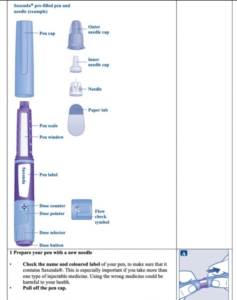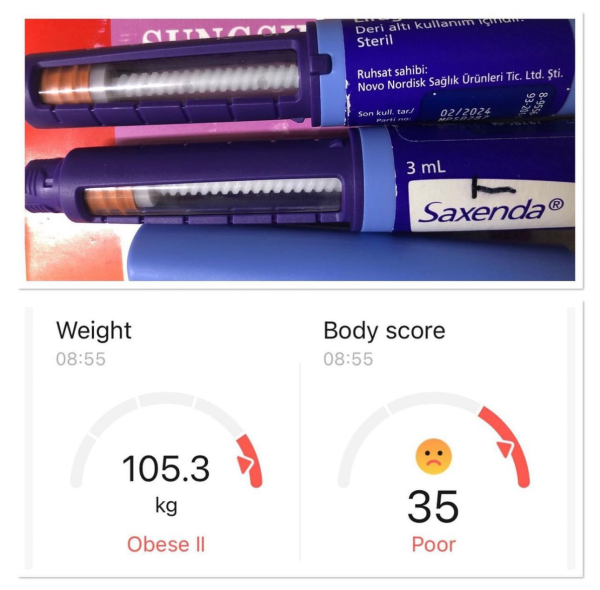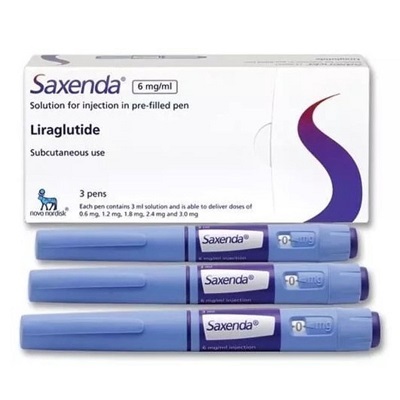What is Saxenda?


How does Saxenda work?
Saxenda works by making you feel less hungry. It mimics a hormone called glucagon-like-peptide (GLP-1), which tells your brain you’re full. This makes it easier to stick to a calorie-controlled diet, which can help you lose weight.

How long does Saxenda stay in your system?
How long does Saxenda take to work?

How effective is Saxenda?
- three out of five participants achieved weight loss of 5% or more (an average weight loss of 12lbs)
- one in three participants achieved weight loss of 10% or more (an average weight loss of 23lbs)
- around 6% of participants achieved weight loss of 20% or more (an average weight loss of 47lbs)


Is Saxenda safe?

How much weight can you lose on Saxenda?


How to use Saxenda
How do I inject Saxenda?
- Check you have the right medication, especially if you use any similar injectable pens.
- Your medication should be clear and colourless. If there is a change in colour or it’s cloudy, do not use your medication and talk to your healthcare provider.
- Attach a new needle to the pen by tearing off the paper seal, pushing it onto the pen, and turning until it is on tight. Always use a new needle for each injection.
- Turn the dose selector until you have the correct dose.
- Remove both caps. Insert the needle into the skin at a straight (90 degree) angle
- Press the dose button and hold for 6 seconds.
- Remove the needle and dispose of it in your sharps bin. (This will be provided by your Saxenda prescriber or health authority).
Where can I inject Saxenda?

How long does a Saxenda pen last?
Saxenda Dosage
| Week | Dose (mg) |
| 1 | 0.6 |
| 2 | 1.2 |
| 3 | 1.8 |
| 4 | 2.4 |
| 5 | 3 |
How to buy Saxenda
Can you buy Saxenda online?
- Complete a short medical questionnaire
- Our GMC registered doctors will review your questionnaire and prescribe a suitable treatment
- You can collect* your medication from any Superdrug store or arrange for it to be delivered free to your home

Can you buy Saxenda over the counter?
Can you get Saxenda for free on the NHS?
Saxenda is available for free on the NHS for people with a BMI of over 35, and it is sometimes considered in those with a BMI over 30 with a weight-related condition such as high blood pressure, diabetes, or sleep apnoea. Occasionally it might be considered in those with a BMI between 27-30 depending on their other medical problems.
NHS weight management services can prescribe Saxenda in specialist centres. It is prescribed in combination with a calorie-controlled diet and exercise programme.
Saxenda Side Effects
Like all medications, Saxenda can cause side effects.
- nausea (feeling sick)
- vomiting (being sick)
- headache
- diarrhoea
- constipation
These side effects usually go away on their own after a few days or weeks. If you are worried about side effects, or if they are getting worse or not going away, talk to your healthcare provider.

- dizziness
- changes to your taste or a dry mouth
- low blood sugar
- passing more wind or belching
- indigestion
- stomach pain or bloating
- gallstones
- tiredness
- redness or inflammation at injection sites
Talk to your doctor if you have any of the following symptoms:
- stomach pain
- worsening of indigestion (heartburn)
- feeling bloated
- passing more gas (flatulence) or burping more than usual
- dry mouth
- feeling tired or having low energy
- feeling dizzy
- feeling shaky, sweaty, fast heartbeat, changes in vision, extreme hunger, nausea, weakness, or difficulty concentrating. These can be signs of low blood sugar and can come on very quickly. If you experience these symptoms, stop Saxenda, contact a doctor and follow your doctor’s advice about treating low blood sugar.
Uncommon side effects (may affect up to 1 in 100 people) include:
- pancreatitis
- dehydration, usually due to vomiting or diarrhoea
- delayed stomach emptying
- inflammation of the gallbladder
- allergic reactions such as skin rash
- malaise (feeling generally unwell)
- fast heartbeat
Rare side effects (may affect up to 1 in 1000 people) include:
- reduced kidney function or acute kidney failure. Symptoms may include peeing less than usual, feeling sick, feeling drowsy, bruising easily, and a metallic taste in the mouth.
- severe pain in the upper part of your abdomen that may radiate to your back
- nausea and vomiting
- fever
- fast heartbeat
Very rarely, a severe allergic reaction called anaphylaxis can occur. Seek immediate medical attention if you experience:
- raised red, itchy rash (hives)
- severe dizziness
- difficulty breathing
- swelling of the face, lips, and tongue
- collapse
Who can use Saxenda?
- have ever had an allergic reaction to Saxenda or any of its ingredients (disodium phosphate dihydrate, propylene glycol, phenol, hydrochloric acid, or sodium hydroxide)
- are pregnant or breastfeeding
- thyroid cancer
- history of thyroid cancer
- Difficulty swallowing.
- Growths or lumps in the neck.
- Hoarseness or loss of voice.
- Shortness of breath.
- have heart failure
- are over 75 years of age
- are taking other medications to help you lose weight
- are taking medications, or have an endocrine disorder that cause you to gain weight
- have problems with your liver or kidneys
- have inflammatory bowel disease
- have diabetic gastroparesis (delayed stomach emptying due to diabetes)
- have ever had inflammation of the pancreas (pancreatitis)
- have gallbladder disease or gallstones
- have ever had thyroid cancer
- have palpitations (awareness of your heartbeat or a fast heartbeat)
Interactions with other medications
- Diabetes medications including insulin and oral sulfonylureas like glimepiride or glibenclamide.
- Blood thinners such as warfarin.




























Reviews
There are no reviews yet.